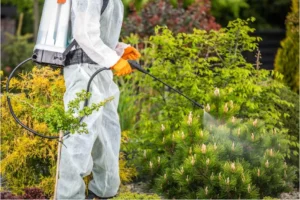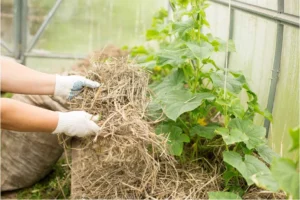How To Treat and Prevent Tomato Plant Diseases

Venturing into tomato cultivation promises a journey filled with the anticipation of plump, juicy harvests. As you embark on this tomato-growing odyssey, envision a garden teeming with vibrant, disease-resistant plants, each fruit bursting with flavor. Arming yourself with the proper knowledge becomes paramount to transforming this vision into reality. So, let’s delve into the intricacies of tomato care, ensuring that every step you take in nurturing your tomato plants brings you closer to a successful and satisfying harvest.


 Apply organic mulch around tomato plants to regulate soil temperature, conserve moisture, and suppress weeds, creating an environment unfavorable for diseases.
Watering Practices:
Apply organic mulch around tomato plants to regulate soil temperature, conserve moisture, and suppress weeds, creating an environment unfavorable for diseases.
Watering Practices:
 Adopt proper watering practices, avoiding overhead irrigation that can splash soil-borne pathogens onto plant foliage. Water at the base to keep leaves dry.
Adopt proper watering practices, avoiding overhead irrigation that can splash soil-borne pathogens onto plant foliage. Water at the base to keep leaves dry.
Common Culprits: Unmasking Tomato Diseases
Spotting the Signs

- Early Warning Signals: Learn to identify subtle signs that hint at potential tomato plant diseases.
- Visual Clues: Explore the nuances in leaf color, texture, and overall plant appearance that can signify trouble.
- Vigilance Pays Off: The importance of regular inspections and how keen observation can nip issues in the bud.
Types of Disease
- Blight Woes:Delve into the notorious world of tomato blights, understanding their characteristics and impact.
- Fungal Foes:Unmask common fungal diseases affecting tomato plants and effective preventive measures.
- Leaf Spot Dilemmas:Explore the challenges of various leaf spot diseases and strategies to combat them.
- Viral Troubles:Shed light on viral infections afflicting tomatoes and ways to fortify your plants against them.
- Root Rot Concerns:Understand the silent threat of root rot and how to maintain soil health for robust plants.
Tomato Plant Diseases Demystified
Blight Basics
- Early Blight Deep Dive:Explore the onset and progression of early blight, identifying its impact on leaves and fruit.
- Late Blight Insights:Understand the distinct characteristics of late blight, a formidable adversary for tomato plants.
- Preventive Measures:Discover practical strategies to prevent blight, including cultural practices and resistant tomato varieties.
Leaf Spotting Woes
- Septoria Leaf Spot:Delve into the intricacies of septoria leaf spot, from its initial signs to advanced stages.
- Target Spot Exploration:Understand the dynamics of target spot, a leaf-spotting disease affecting tomato plants.
- Management Strategies:Learn about cultural and chemical methods to manage and prevent various leaf-spotting ailments.
Fungal Tomato Diseases
- Powdery Mildew Primer:Uncover the characteristics of powdery mildew and effective treatments to curb its spread.
- Fusarium Wilt Fundamentals:Explore fusarium wilt, its impact on tomato plants, and strategies for soil-borne disease prevention.
- Verticillium Wilt Wisdom:Understand the symptoms and preventive measures for tomato plants afflicted with verticillium wilt.
Treatment Strategies: Nipping Ailments in the Bud
Biological Control Methods:

- Introduce beneficial insects like ladybugs that prey on harmful pests affecting tomato plants.
- Utilize nematodes, microscopic organisms, to control soil-borne pathogens and protect plant roots.
Companion Planting Techniques:
- Plant garlic, basil, or marigolds near tomato plants to repel pests and enhance overall plant health.
- Explore the benefits of planting companion herbs and flowers to create a natural deterrent against diseases.
Adjusting Watering Practices:
- Implement a drip irrigation system to ensure consistent moisture, reducing the risk of foliar diseases.
- Water in the morning to allow foliage to dry throughout the day, minimizing conditions favorable for disease development.
Pruning and Thinning Strategies:
- Regularly prune tomato plants to enhance air circulation, reducing the likelihood of fungal infections.
- Thin out excess foliage to promote sunlight penetration, which discourages the growth of specific pathogens.
Copper-Based Sprays:
- Consider copper-based fungicides as an effective preventive measure against bacterial and fungal infections.
- Apply copper sprays during the early stages of plant growth and at intervals to maintain protection.
Crop Rotation Practices:
- Rotate tomato crops annually to prevent the buildup of soil-borne diseases in the exact location.
- Plan a diverse crop rotation strategy to break disease cycles and maintain soil health.
Implementing Proper Mulching:
- Apply organic mulch around tomato plants to regulate soil temperature and moisture, reducing the risk of soil-borne diseases.
- Avoid excessive mulch depth to prevent the accumulation of excess moisture.
Beneficial Microbial Inoculants:
- Introduce beneficial microorganisms like mycorrhizal fungi to enhance the plant’s natural defense mechanisms.
- Use microbial inoculants as soil amendments to promote a healthy microbial balance, suppressing harmful pathogens.
Spot on Tomato Leaves: Causes and Cures
Spotting the Culprits
Tomato plants are susceptible to various leaf issues, and understanding the underlying causes is crucial for effective treatment. Common culprits include fungal infections, bacterial diseases, pests, and environmental stressors. Fungal Infections:- Causes: Fungi like early blight and late blight thrive in humid conditions.
- Cures: Apply fungicidal sprays, ensure proper ventilation, and avoid overhead watering.
- Causes: Bacteria, such as bacterial spots, can enter through wounds or be spread by splashing water.
- Cures: Copper-based sprays and proper sanitation practices help manage bacterial issues.
- Causes: Insects like aphids or spider mites can cause stippling and spots.
- Cures: Introduce beneficial insects, use neem oil, and regularly inspect for pest presence.
- Causes: Excessive heat, nutrient deficiencies, or erratic watering can lead to leaf problems.
- Cures: Maintain consistent watering schedules, provide adequate nutrients, and protect plants from extreme conditions.
Holistic Healing: Utilize holistic approaches to remedy leaf issues
While specific treatments address individual causes, holistic practices can contribute to plant health and resilience. Companion Planting: Integrate companion plants like basil or marigolds to deter pests and improve the overall health of tomato plants. Proper Spacing: Ensure adequate spacing between plants for better air circulation, reducing the risk of fungal infections. Organic Mulching: Mulch with organic materials to regulate soil temperature, retain moisture, and prevent soil-borne diseases. Balanced Nutrition: Provide a well-balanced fertilizer to ensure tomato plants receive essential nutrients, enhancing their ability to fight diseases. Regular Inspection: Perform routine checks for early signs of issues, allowing for timely intervention and preventing the spread of problems.Proactive Measures: Shielding Your Tomatoes from Diseases
Implement strategies to prevent tomato diseases
Adopting proactive measures is paramount to ensure a thriving tomato garden. By incorporating preventive practices, you can significantly reduce the risk of diseases affecting your precious plants. Crop Rotation: Rotate tomato crops annually to disrupt the life cycles of soil-borne pathogens and reduce disease buildup. Seed Selection: Opt for disease-resistant tomato varieties when selecting seeds. Resistant plants offer a natural defense against specific ailments. Quarantine New Plants: Quarantine new additions to your garden, mainly if acquired from external sources. This helps prevent introducing potential diseases. Sterilize Garden Tools: Regularly sterilize gardening tools to prevent the transfer of pathogens. Clean, sharp tools minimize the risk of infections. Sanitation Practices: Maintain a clean garden environment by promptly removing debris, fallen leaves, and plant residues. This reduces the breeding grounds for pests and pathogens.Soil Health
A healthy soil foundation is vital for robust tomato plants. Understanding the relationship between soil health and plant wellness can guide you in creating an environment that naturally resists diseases. Balanced pH Levels: Test and adjust soil pH to the optimal range for tomatoes (around 6.0 to 6.8). Proper pH enhances nutrient absorption and plant vitality. Amend Soil Structure: Improve soil structure by incorporating organic matter like compost. Well-draining, nutrient-rich soil reduces the risk of root-related diseases. Beneficial Microorganisms: Encourage the presence of beneficial microorganisms by using organic amendments. These microorganisms contribute to a healthy soil ecosystem. Mulching Techniques: Apply organic mulch around tomato plants to regulate soil temperature, conserve moisture, and suppress weeds, creating an environment unfavorable for diseases.
Watering Practices:
Apply organic mulch around tomato plants to regulate soil temperature, conserve moisture, and suppress weeds, creating an environment unfavorable for diseases.
Watering Practices:
 Adopt proper watering practices, avoiding overhead irrigation that can splash soil-borne pathogens onto plant foliage. Water at the base to keep leaves dry.
Adopt proper watering practices, avoiding overhead irrigation that can splash soil-borne pathogens onto plant foliage. Water at the base to keep leaves dry.




